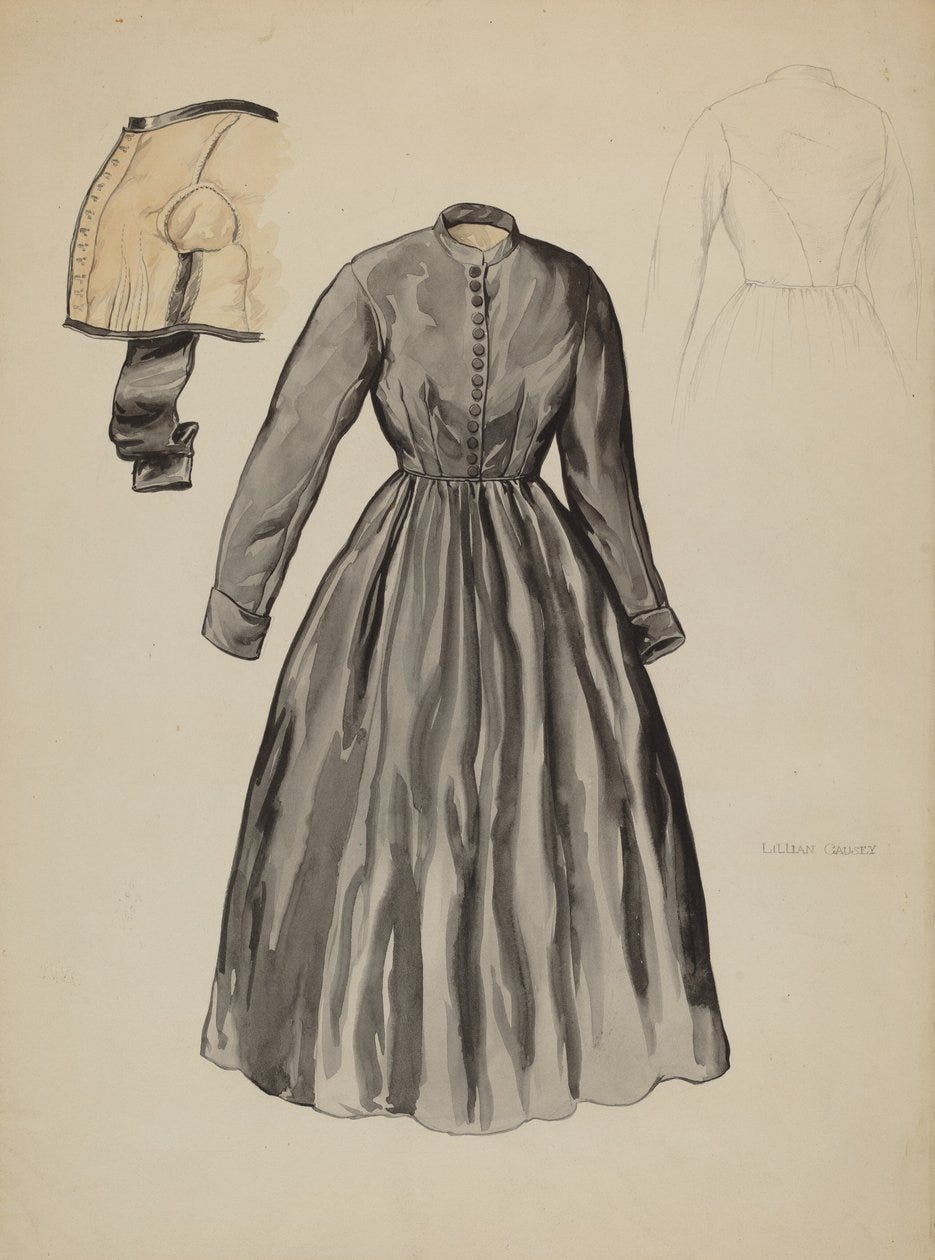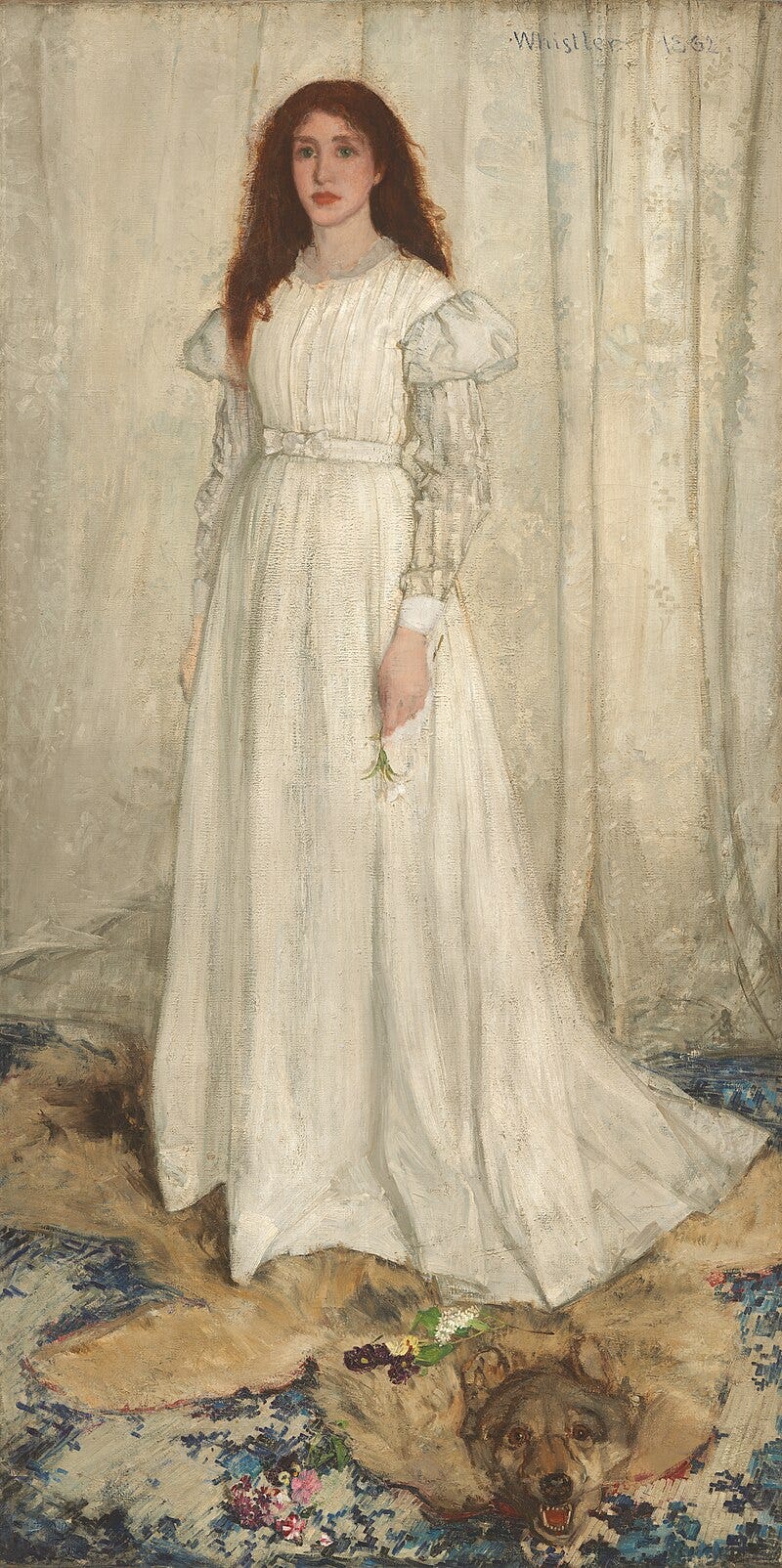What is Dorothea Brooke's Color Season?
We already know her kibbe type.
Normally, picking the art for a post is my favorite part; a way to reward myself for writing, or else cajole myself into it. That is not how I felt picking art for this post. Now I get why covers for Middlemarch are so universally bad, why they so often freak out and use Whistler’s Symphony in White, No. 1: the White Girl, which, despite being a virtuosic performance of solving a difficult color problem, portrays:
sleeves which are significantly “less bare of style than those in which the Blessed Virgin appeared to Italian painters”
a cute little bow and pintucks which do seem to be there for “mere effect”
Beautiful curly wavy little tendrils which create a lovely soft, detailed, gradient border around the model’s face—but which are totally at odds with “the simple lines of [Dorothea’s] dark-brown hair”
Covers for Middlemarch are so bad because painters like painting women in fashionable clothes. Or at least interestingly old-fashioned clothes! They don’t go around painting unfashionable “Quakerish” outfits like Dorothea’s. It’s ironic because in the book, artists want to paint her. But they don’t want to paint her in her “pelisse with sleeves hanging all out of the fashion,” they want to dress her up as a saint or a Roman.
Dorothea Brooke is obviously a classic. Classics become more beautiful the more you remove. Maybe she’s got a hint of natural, but not that much, and nothing from other style types.
(I sometimes wonder if Dorothea would be quite so good a woman if she wasn’t a classic. If Rosamund Vincy—whose “half nymph, half child” beauty makes me peg her as an Ethereal Ingenue—renounced her frills, she’d be giving up much more than Dorothea.)1
But….what is Dorothea’s color season????
I’ve said before that there are color season rationalists and color season empiricists—people who believe you can figure out someone’s season from the qualities of their skin, hair, and eyes, and people who believe you actually have to see the subject in different colors to make the determination. I think we have enough information to satisfy both of them.
Dorothea has “dark-brown hair.” We also know that “there was gem-like brightness on her coiled hair and in her hazel eyes; there was warm red life in her lips; her throat had a breathing whiteness.” Dark hair, hazel eyes, and warm undertones are a classic Autumn lineup. But….I’m a color season empiricist, and I don’t really think Dorothea is an Autumn.
We see Dorothea wearing white, black, gray, and blue-gray. That by itself wouldn’t be enough information, people wear out-of-season colors all the time, but we also know that she looks really good in them: when we see her “glowing from her morning toilet as only healthful youth can glow,” she’s wearing a blue-gray pelisse. If she looks this good in cool colors, that kind of rules out warm seasons like Autumn and Spring. (I think when Eliot described the “warm red life” in Dorothea’s lips, she wasn’t using warm to modify red in terms of color theory, but just saying that the life was both warm and red.)
So she’s a cool season—but is she Summer2 or Winter? That depends on her level of contrast. Black and white are higher-contrast colors, classic Winter colors. Gray can go either way. But blue-gray is the quintessential summer color, and Eliot goes into her greatest raptures over Dorothea’s coloring when Dorothea is in the blue-gray. When she and Celia go through their mother’s jewel-box,3 Dorothea is indifferent to the “necklace of purple amethysts set in exquisite gold work” and the “pearl cross with five brilliants” (pearl and diamond being very Summer gems) but she’s moved by the emeralds—saturated, cool, bright, high-contrast, central examples of Winter color choices. So we consistently have her in cool colors, but varying contrast levels. She’s wavering between True Summer and True Winter for me.
Ultimately, I’m going to say she’s a True Winter, because “she looks handsomer than ever in her mourning.”
But it’s strongly to Eliot’s credit that it’s even possible to make this argument. Russian novelists are always spending paragraphs cataloguing each feature of someone’s face and leaving me baffled at the end. I know that Aglaia looks like a healthy California volleyball player and Nastassia looks like Madame X, but I really had to work to picture them. Few novelists are as good at physical descriptions—possibly because few novelists have had lives as constrained by physical appearance as poor, lonely Eliot. And few novelists have ultimately married as happily as she did! Happy ending for the Mary Garth Vincies and the Mary Ann Leweses.
As far as the other young ladies of Middlemarch: Mary Garth, with her “broad face and square brow, well-marked eyebrows and curly dark hair, a certain expression of amusement in her glance,” is somewhere on the Natural spectrum, maybe a Natural Gamine; “innocent-looking” Celia, with her “white muslin and light curls,” the “Henrietta-Maria style of [her] head and neck,” is probably an Ingenue.
Yes, yes, summer is actually a hot part of the year. I know.
Paging Dr. Freud.




Wait so what's the middle ground between the rationalists and the empiricists? Like I feel you could make a pretty bold prediction by looking at one's features but you still need to see the actual result to make a complete judgment.
(I feel like there must be an Everything Everywhere All At Once-style nearby adjacent alternate timeline where I was really into fashion or something.)
The Bostonians movie had Olive wearing a corset with boning, I couldn't believe it.